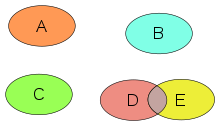This article needs additional citations for verification. (January 2014) |



In mathematics, the intersection of two or more objects is another object consisting of everything that is contained in all of the objects simultaneously. For example, in Euclidean geometry, when two lines in a plane are not parallel, their intersection is the point at which they meet. More generally, in set theory, the intersection of sets is defined to be the set of elements which belong to all of them. Unlike the Euclidean definition, this does not presume that the objects under consideration lie in a common space.
Intersection is one of the basic concepts of geometry. An intersection can have various geometric shapes, but a point is the most common in a plane geometry. Incidence geometry defines an intersection (usually, of flats) as an object of lower dimension that is incident to each of original objects. In this approach an intersection can be sometimes undefined, such as for parallel lines. In both cases the concept of intersection relies on logical conjunction. Algebraic geometry defines intersections in its own way with intersection theory.